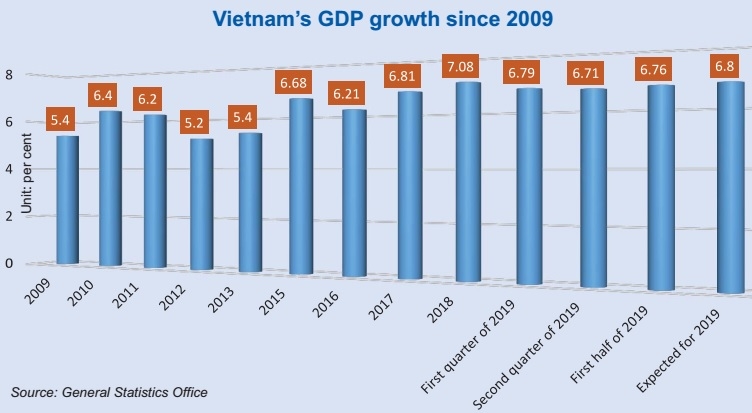Historic GDP rate rise as Vietnam revises figures
 |
Last week, the face of Vietnam’s macro-economic situation changed dramatically after the General Statistics Office (GSO) announced that, in fact, the economy annually grew by an additional 24.5 per cent for the 2010-2017 period, with specific details to be released soon.
The increase means that the country gained an additional average of $40 billion in GDP each year, and per capita income of an extra $500.
The impressive figures follows the GSO’s ongoing reassessment of the economy’s GDP for 2010-2017 based on the methodology recommended by the United Nations’ statistics agency, which employs sources of data deemed to better reflect the performance of the economy. The International Monetary Fund (IMF) has also helped Vietnam in this crucial work.
“Now is the right time for Vietnam to reassess its GDP scale. GDP is an important macro-economic index,” said a GSO statement released last week. “The reassessment of the GDP size is aimed to more accurately reflect the scale and capacity of the economy, enhancing the country’s economic status regionally and internationally.”
In the context that Vietnam is designing its Socio-economic Development Strategy for 2021-2030 and the Socio-economic Development Plan for 2021-2025, the reassessment will help the country make correct orientations for national development over the next decade.
Since 2010, many nations including the US, Canada, Germany, Russia, Italy, Croatia, and Indonesia have reviewed and then revised their GDP scale and other relevant macro indexes. After such revision, these nations’ GDP increased strongly, such as an additional $560 billion for the US in 2012, $36.4 billion for Canada in 2011, and $305 billion for China in 2013. Many other nations also saw their GDP climb in 2013 after review, such as Russia (24.3 per cent), Germany (3 per cent), Italy (7 per cent), Bulgaria (31.2 per cent), and Romania (28.4 per cent).
IMPACTS
According to the GSO, the reassessment will have significant impacts on the economy.
Specifically, it will create a remarkable increase in the GDP value and per capita GDP, which will help lead to changes in socio-economic development orientations and consumption models of the public. This also means that Vietnam may sooner reach its status of a high middle-income nation.
In addition, the reassessment will help change the GDP structure, with a rise in the contribution of the industrial, construction, and service sectors, and a reduction in the agro-forestry-fishery sector.
Besides that, with the reassessment, a climb in GDP size and per capita GDP can increase Vietnam’s contributions to international organisations of which Vietnam is a member.
According to the GSO, though Vietnam’s statistics inputs have been improving, previous data gathered remained insufficient for accurately calculating annual GDP targets. Furthermore, the development of the private sector has not been reflected fully in its statistical data.
For example, the performance of more than 70,000 enterprises, including several private big ones, has yet to be included in the calculation of the existing GDP size.
Vietnam’s statistical surveys, the main data sources for the GSO, have been sufficient to measure industry trends but limitations in sharing information between ministries has meant that the GSO cannot accurately determine how much added value industries contribute to the economy.
Robert Dippelsman, vice head of the IMF’s Statistics Department, said that the review and update of GDP is normal, especially for advancing nations like Vietnam. Therefore, the IMF highly appreciates the GSO’s moves to conduct economic censuses to ensure that 100 per cent of businesses are put under review.
“All nations now need to reassess their GDP growth. However the work would be more difficult for Vietnam as the country is a very fast-changing nation,” he said. “The GSO currently has a very difficult task which is how to co-ordinate with all ministries and agencies to review all data before reaching final accurate data.”
According to the IMF, Vietnam’s data provision “has some shortcomings, but is broadly adequate for surveillance. Most affected areas are the financial sector, national accounts, government finance, and external sector statistics.”
IMF consultant Emnanuel Manolikakis also said that Vietnam is witnessing rapid changes in economic structure, and in the number of enterprises, especially small- and medium-sized ones, which totalled about 730,000 by late last year, occupying 97 per cent of the total number of enterprises in the economy.
Moreover, household-based businesses are also mushrooming, making it complex for statistical work to be conducted.
ON THE RISE
At recent meetings and conferences on Vietnam’s economic development, the World Bank in Vietnam has maintained that over the past 30 years, the country has attained a remarkable development record.
Economic and political reforms under doi moi, launched in 1986, have spurred rapid economic growth and development and transformed Vietnam from one of the world’s poorest nations to a lower middle-income country.
“Vietnam’s economy continues to show fundamental strength, supported by robust domestic demand and export-oriented manufacturing,” the bank stated in a document. “The extreme poverty rate is estimated to have declined to below 3 per cent. Following 6.8 per cent growth in 2017, preliminary data indicate that GDP growth accelerated to 7.1 per cent in 2018, underpinned by a broad-based pickup in economic activity.”
Last year, Vietnam’s economy grew to the highest in a decade, and stood at $223.9 billion. The government has targeted annual GDP growth of between 6.5-7 per cent a year during the 2016-2020 period. The rate is expected to be 6.8 per cent this year.
Meanwhile, international organisations have varying forecasts for Vietnam, such as the IMF (6.5 per cent), the World Bank (6.6 per cent), and the Asian Development Bank (6.8 per cent).
However, Vietnam is expected to remain its highest growth rate in the region this year, as compared to the likes of China (6.3 per cent), Indonesia (5.2 per cent), and the Philippines (6.4 per cent).
Global data provider TradingEconomics last week forecast that under its econometric models, GDP in Vietnam is expected to be $255 billion by the end of this quarter. In the long-term, the figure is projected to trend around $281 billion in 2020.
| Ousmane Dione - Vietnam country director World Bank
The world is changing rapidly and Vietnam needs to keep pace or it will risk falling behind. Global trade patterns are shifting. Asia will continue to rise and is expected to become the centre of gravity in the global economy in the next decade. The rising Asian consumer markets present key opportunities for Vietnam. At the same time, the increasing adoption of advanced manufacturing technologies – robotics, 3D printing, and smart manufacturing in labour-scarce economies and in China could challenge Vietnam’s ability to continue to rely on export-driven growth. But they may also create new opportunities for faster technological catch-up and even leapfrogging. Domestically, Vietnam will have to content with a rapidly-aging population, tepid productivity, and sluggish investment growth which weighs on Vietnam’s medium-term growth potential. Many of the drivers that propelled the country’s growth in the past will diminish over the next decade. Gains from structural transformation – workers moving from lower-productivity agriculture to higher productivity manufacturing and services – is running its course. Wages are rising and will start to erode Vietnam’s current comparative advantage in relatively low-value, labour-intensive segments of the global value chains. So while Vietnam has every potential to sustain its development success, it will have to seize opportunities, manage risks, and push ahead with bold reforms. The Socio-economic Development Strategy and Socio-economic Development Plan are Vietnam’s golden opportunities because they will shape the country’s development roadmap for the next decade. We cannot afford to miss these opportunities. This decade is a critical time for Vietnam as it confronts new challenges and seeks to fulfill its ambition of becoming a high-income economy by 2045. |
What the stars mean:
★ Poor ★ ★ Promising ★★★ Good ★★★★ Very good ★★★★★ Exceptional
Related Contents
Latest News
More News
- Double-digit GDP growth within reach with shift to higher-value expansion (January 06, 2026 | 08:33)
- Ho Chi Minh City projects $10.5 billion remittance inflows in 2025 (December 31, 2025 | 18:58)
- Digital shift reshaping Vietnam’s real estate brokerages (December 31, 2025 | 18:54)
- New decree sharpens enforcement in securities market (December 31, 2025 | 18:53)
- Voluntary Sustainability Standards pave way for Vietnam’s agricultural exports (December 31, 2025 | 09:00)
- Gold market reform advances as SBV receives applications for bullion production (December 30, 2025 | 12:07)
- Textile apparel firms deliver robust earnings despite global tariff pressures (December 30, 2025 | 10:09)
- Ho Chi Minh City hits $8.37 billion in FDI (December 29, 2025 | 08:28)
- Tax sector wraps up 2025 and sets priorities for next year (December 25, 2025 | 14:00)
- Heavy industries set for pilot greenhouse gas quotas (December 25, 2025 | 10:00)


 Tag:
Tag:

















 Mobile Version
Mobile Version